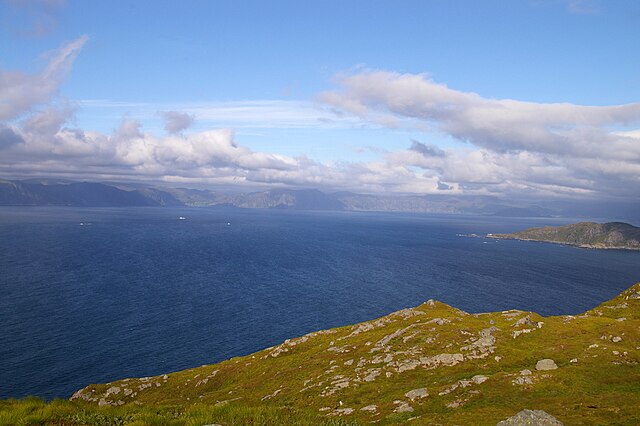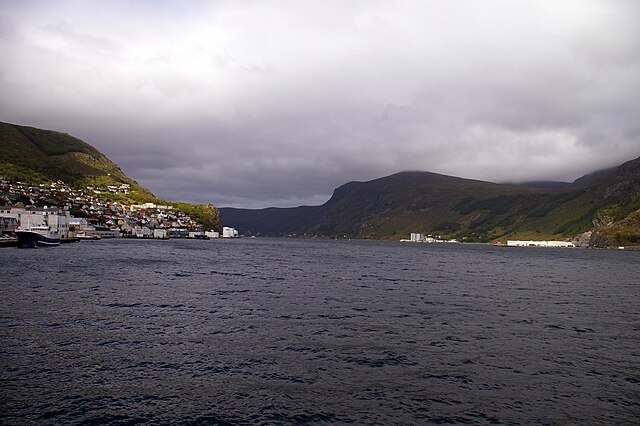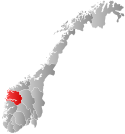Vågsøy
Former municipality in Sogn og Fjordane, Norway From Wikipedia, the free encyclopedia
Former municipality in Sogn og Fjordane, Norway From Wikipedia, the free encyclopedia
Vågsøy is a former municipality in the old Sogn og Fjordane county, Norway. It was located in the traditional district of Nordfjord. The municipality's administrative center was the town Måløy. Other population centers in Vågsøy included the villages of Bryggja, Deknepollen, Holvika, Kvalheim, Langeneset, Raudeberg, Refvika, Silda, Tennebø, Totland, Vedvika, and Vågsvåg. The municipality included the island of Vågsøy, several small surrounding islands, and part of the mainland. On 1 January 2020, the municipality was dissolved and divided between Kinn Municipality and Stad Municipality in Vestland county.



Vågsøy Municipality
Vågsøy kommune | |
|---|---|
 View of the town of Måløy | |
|
| |
 Sogn og Fjordane within Norway | |
 Vågsøy within Sogn og Fjordane | |
| Coordinates: 61°55′16″N 05°11′37″E | |
| Country | Norway |
| County | Sogn og Fjordane |
| District | Nordfjord |
| Established | 1 Jan 1964 |
| • Preceded by | Nord-Vågsøy and Sør-Vågsøy municipalities |
| Disestablished | 1 Jan 2020 |
| • Succeeded by | Kinn and Stad municipalities |
| Administrative centre | Måløy |
| Government | |
| • Mayor (2015-2019) | Kristin Maurstad (Ap) |
| Area (upon dissolution) | |
| • Total | 176.70 km2 (68.22 sq mi) |
| • Land | 171.33 km2 (66.15 sq mi) |
| • Water | 5.37 km2 (2.07 sq mi) 3% |
| • Rank | #345 in Norway |
| Population (2018) | |
| • Total | 6,001 |
| • Rank | #175 in Norway |
| • Density | 35/km2 (90/sq mi) |
| • Change (10 years) | |
| Demonym | Vågsøyværing[1] |
| Official language | |
| • Norwegian form | Nynorsk |
| Time zone | UTC+01:00 (CET) |
| • Summer (DST) | UTC+02:00 (CEST) |
| ISO 3166 code | NO-1439[3] |
At the time of its dissolution in 2020, the 177-square-kilometre (68 sq mi) municipality is the 345th largest by area out of the 422 municipalities in Norway. Vågsøy is the 175th most populous municipality in Norway with a population of 6,001. The municipality's population density is 35 inhabitants per square kilometre (91/sq mi) and its population has increased by 0.1% over the last decade.[4][5]
The municipality of Vågsøy was the second largest fishing municipality in Norway, and it was home to one of Norway's most modern fish-processing plants.[6]
Historically, Vågsøy was part of Selje Municipality (see formannskapsdistrikt law). On 1 January 1910, the municipality of Selje was split into three separate municipalities: Nord-Vågsøy (population: 1,111), Sør-Vågsøy (population: 1,517), and Selje (population: 3,367). Nord-Vågsøy included the northern half of the island of Vågsøy and Sør-Vågsøy included the southern part of the island and some of the mainland.[7]
During the 1960s, there were many municipal mergers across Norway due to the work of the Schei Committee. On 1 January 1964, a new municipality of Vågsøy was created by merging the following areas together:[7]
The new municipality had an initial population of 6,962.[7]
On 1 January 2020, Vågsøy Municipality was dissolved. The Bryggja-Totland area in the eastern part of Vågsøy was merged with the neighboring municipalities of Eid and Selje to become the new Stad Municipality. The rest of Vågsøy was merged with the municipality of Flora to the south to create a new (non-contiguous) municipality called Kinn.[8]
The municipality (originally the parish) is named after the island of Vågsøy (Old Norse: Vágsey). The first element is the genitive case of vágr which means "bay" or "inlet". The last element is ey which means "island".[9][10]
The coat of arms of Vågsøy was granted on 27 March 1987 and they were in use until 1 January 2020 when the municipality was dissolved. The official blazon is "Azure, two rudders in bend| argent" (Norwegian: I blått to skråstilte sølv ror). This means the arms have a blue field (background) and the charge is a set of two rudders lined up diagonally. The charge has a tincture of argent which means it is commonly colored white, but if it is made out of metal, then silver is used. The arms depict the type of rudders used in the one-man boats which have been used for a long time in this area. This design was chosen to symbolize "steering on land and sea". The arms were designed by Inge Rotevatn. The municipal flag has the same design as the coat of arms.[11][12][13]
The Church of Norway has one parish (sokn) within the municipality of Vågsøy. It is part of the Nordfjord prosti (deanery) in the Diocese of Bjørgvin.
| Parish (sokn) | Church name | Location of the church | Year built |
|---|---|---|---|
| Vågsøy | Nord-Vågsøy Church | Raudeberg | 1960 |
| Sør-Vågsøy Church | Måløy | 1907 | |
| Totland Church | Totland | 1912 |
While it existed, this municipality was responsible for primary education (through 10th grade), outpatient health services, senior citizen services, unemployment, social services, zoning, economic development, and municipal roads. During its existence, this municipality was governed by a municipal council of directly elected representatives. The mayor was indirectly elected by a vote of the municipal council.[14] The municipality was under the jurisdiction of the Sogn og Fjordane District Court and the Gulating Court of Appeal.
The municipal council (Kommunestyre) of Vågsøy was made up of 27 representatives that were elected to four year terms. The party breakdown of the final municipal council was as follows:
| Party name (in Nynorsk) | Number of representatives | |
|---|---|---|
| Labour Party (Arbeidarpartiet) | 6 | |
| Progress Party (Framstegspartiet) | 2 | |
| Conservative Party (Høgre) | 8 | |
| Christian Democratic Party (Kristeleg Folkeparti) | 1 | |
| Red Party (Raudt) | 1 | |
| Centre Party (Senterpartiet) | 4 | |
| Liberal Party (Venstre) | 3 | |
| Cross-party list for Vågsøy (Tverrpolitisk liste for Vågsøy) | 2 | |
| Total number of members: | 27 | |
| Party name (in Nynorsk) | Number of representatives | |
|---|---|---|
| Labour Party (Arbeidarpartiet) | 3 | |
| Progress Party (Framstegspartiet) | 4 | |
| Conservative Party (Høgre) | 8 | |
| Christian Democratic Party (Kristeleg Folkeparti) | 2 | |
| Centre Party (Senterpartiet) | 4 | |
| Socialist Left Party (Sosialistisk Venstreparti) | 1 | |
| Liberal Party (Venstre) | 4 | |
| Bryggja List (Bryggjalista) | 1 | |
| Total number of members: | 27 | |
| Party name (in Nynorsk) | Number of representatives | |
|---|---|---|
| Labour Party (Arbeidarpartiet) | 6 | |
| Progress Party (Framstegspartiet) | 4 | |
| Conservative Party (Høgre) | 3 | |
| Red Electoral Alliance (Raud Valallianse) | 1 | |
| Centre Party (Senterpartiet) | 7 | |
| Socialist Left Party (Sosialistisk Venstreparti) | 1 | |
| Liberal Party (Venstre) | 4 | |
| Bryggja List (Bryggjalista) | 1 | |
| Total number of members: | 27 | |
| Party name (in Nynorsk) | Number of representatives | |
|---|---|---|
| Labour Party (Arbeidarpartiet) | 9 | |
| Progress Party (Framstegspartiet) | 3 | |
| Conservative Party (Høgre) | 2 | |
| Christian Democratic Party (Kristeleg Folkeparti) | 2 | |
| Red Electoral Alliance (Raud Valallianse) | 1 | |
| Centre Party (Senterpartiet) | 4 | |
| Liberal Party (Venstre) | 5 | |
| Bryggja List (Bryggjalista) | 1 | |
| Total number of members: | 27 | |
| Party name (in Nynorsk) | Number of representatives | |
|---|---|---|
| Labour Party (Arbeidarpartiet) | 7 | |
| Progress Party (Framstegspartiet) | 3 | |
| Conservative Party (Høgre) | 5 | |
| Christian Democratic Party (Kristeleg Folkeparti) | 4 | |
| Centre Party (Senterpartiet) | 3 | |
| Liberal Party (Venstre) | 13 | |
| Bryggja List (Bryggjalista) | 2 | |
| Total number of members: | 37 | |
| Party name (in Nynorsk) | Number of representatives | |
|---|---|---|
| Labour Party (Arbeidarpartiet) | 6 | |
| Conservative Party (Høgre) | 8 | |
| Christian Democratic Party (Kristeleg Folkeparti) | 4 | |
| Centre Party (Senterpartiet) | 4 | |
| Liberal Party (Venstre) | 14 | |
| Common list for Bryggja (Samlingsliste for Bryggja) | 1 | |
| Total number of members: | 37 | |
| Party name (in Nynorsk) | Number of representatives | |
|---|---|---|
| Labour Party (Arbeidarpartiet) | 6 | |
| Progress Party (Framstegspartiet) | 2 | |
| Conservative Party (Høgre) | 5 | |
| Christian Democratic Party (Kristeleg Folkeparti) | 5 | |
| Red Electoral Alliance (Raud Valallianse) | 1 | |
| Centre Party (Senterpartiet) | 6 | |
| Liberal Party (Venstre) | 4 | |
| Non-political mainland list (Upolitisk fastlandslist) | 4 | |
| Common list for Bryggja (Samlingsliste for Bryggja) | 2 | |
| Local list for Holvik and Våge/Oppedal (Bygdeliste for Holvik og Våge/Oppedal) | 2 | |
| Total number of members: | 37 | |
| Party name (in Nynorsk) | Number of representatives | |
|---|---|---|
| Labour Party (Arbeidarpartiet) | 6 | |
| Progress Party (Framstegspartiet) | 1 | |
| Conservative Party (Høgre) | 10 | |
| Christian Democratic Party (Kristeleg Folkeparti) | 4 | |
| Red Electoral Alliance (Raud Valallianse) | 2 | |
| Centre Party (Senterpartiet) | 1 | |
| Liberal Party (Venstre) | 3 | |
| Non-political mainland list (Upolitisk fastlandslist) | 4 | |
| Common list for Bryggja (Samlingsliste for Bryggja) | 2 | |
| Common list for Nord-Vågsøy (Samlingsliste for Nord-Vågsøy) | 4 | |
| Total number of members: | 37 | |
| Party name (in Nynorsk) | Number of representatives | |
|---|---|---|
| Labour Party (Arbeidarpartiet) | 8 | |
| Conservative Party (Høgre) | 9 | |
| Christian Democratic Party (Kristeleg Folkeparti) | 5 | |
| Red Electoral Alliance (Raud Valallianse) | 2 | |
| Liberal Party (Venstre) | 2 | |
| Non-party common list for North Vågsøy (Upolitisk samlingsliste for Nord-Vågsøy) | 5 | |
| Non-party election list for Bryggja (Upolitisk valliste for Bryggja) | 3 | |
| Non-party mainland list (Upolitisk Fastlandsliste) | 3 | |
| Total number of members: | 37 | |
| Party name (in Nynorsk) | Number of representatives | |
|---|---|---|
| Labour Party (Arbeidarpartiet) | 6 | |
| Conservative Party (Høgre) | 9 | |
| Christian Democratic Party (Kristeleg Folkeparti) | 5 | |
| Liberal People's Party (Liberale Folkepartiet) | 2 | |
| Centre Party (Senterpartiet) | 1 | |
| Liberal Party (Venstre) | 3 | |
| Non-party common list for North Vågsøy (Upolitisk samlingsliste for Nord-Vågsøy) | 4 | |
| Non-party common list for the mainland (Upolitisk samlingsliste for fastlandet) | 3 | |
| Common list for Almenningen and Bryggja (Samlingsliste for Almenningen og Bryggja) | 3 | |
| Vågsvåg, Torskangerpoll, and Oppedal common list (Vågsvåg, Torskangerpoll og Oppedals fellesliste) | 1 | |
| Total number of members: | 37 | |
| Party name (in Nynorsk) | Number of representatives | |
|---|---|---|
| Labour Party (Arbeidarpartiet) | 8 | |
| Conservative Party (Høgre) | 5 | |
| Christian Democratic Party (Kristeleg Folkeparti) | 8 | |
| New People's Party (Nye Folkepartiet) | 3 | |
| Centre Party (Senterpartiet) | 1 | |
| Liberal Party (Venstre) | 2 | |
| Våge, Torskangerpoll, and Oppedal Common List (Våge, Torskangerpoll og Oppedals Felleslister) | 1 | |
| Common list for the mainland, Almenningen, and Bryggja (Samlingsliste for Fastlandet, Almenningen og Bryggja) | 6 | |
| Non-party Common List for North Vågsøy (Upolitisk Samlingsliste for Nord-Vågsøy) | 3 | |
| Total number of members: | 37 | |
| Party name (in Nynorsk) | Number of representatives | |
|---|---|---|
| Labour Party (Arbeidarpartiet) | 8 | |
| Conservative Party (Høgre) | 3 | |
| Christian Democratic Party (Kristeleg Folkeparti) | 7 | |
| Liberal Party (Venstre) | 3 | |
| Local List(s) (Lokale lister) | 16 | |
| Total number of members: | 37 | |
| Party name (in Nynorsk) | Number of representatives | |
|---|---|---|
| Labour Party (Arbeidarpartiet) | 10 | |
| Conservative Party (Høgre) | 4 | |
| Christian Democratic Party (Kristeleg Folkeparti) | 4 | |
| Liberal Party (Venstre) | 3 | |
| Local List(s) (Lokale lister) | 16 | |
| Total number of members: | 37 | |
| Party name (in Nynorsk) | Number of representatives | |
|---|---|---|
| Labour Party (Arbeidarpartiet) | 5 | |
| Conservative Party (Høgre) | 5 | |
| Joint List(s) of Non-Socialist Parties (Borgarlege Felleslister) | 4 | |
| Local List(s) (Lokale lister) | 23 | |
| Total number of members: | 37 | |
The mayors (Nynorsk: ordførar) of Vågsøy:[26]
In 2007, Vågsøy participated in a trial where the mayor was directly elected. The sitting mayor, Roger B. Silden, received 44.1% of the votes and won the election. His party (the Norwegian Labour Party), however, did poorer than in 2003 and it became the second largest party with only 21.8% of the votes.



Vågsøy was made up of the mainland and islands on the northern and outer shore of the Nordfjorden. The municipality was named after its largest island, Vågsøy. Other populated islands in Vågsøy included Silda, Moldøen, and Husevågøy. The lake Degnepollvatnet was located between the villages of Degnepoll and Tennebø.
The municipalities of Selje (in Sogn og Fjordane county) and Vanylven (in Møre og Romsdal county) bordered it to the north, the municipality of Eid was located to the east, the municipality of Bremanger was to the south, and the North Sea bordered Vågsøy to the west.
Måløy attained city status in 1997. It lies along the Ulvesundet strait on the island of Vågsøy, and is joined to the mainland by the 1,224-metre (4,016 ft) long Måløy Bridge, a structure that forms a gateway for all seagoing traffic. The Coastal Steamer (Hurtigruten) has daily departures.[6] The old part of the city lies on the island of Moldøen, from which the city that has expanded onto the mainland and further west to Holvik, has its name.
Over thousands of years, ocean waves have ground the rock to the shape it has today. It is located in the village of Oppedal, approximately 10 kilometres (6.2 mi) west of the center of Måløy. Every year many visitors come to Oppedal to take a closer look at the stone. The Kannestein or Kanne Stone was formed by loose stones and the pounding of the waves over a period of thousands of years, and stands today as a 4 to 5 metres (13 to 16 ft) high, narrow-footed rock. This is caused by stones having split loose, which have knocked and gnawed at the rockface until they have become polished and rounded. Loose stones have then worked themselves deeper into the rock. New stones have come, and in time the potholes have become deeper and wider. Several potholes near to each other have been polished for so long that the sides have been rubbed away, leaving just the middle section, such as the Kanne Stone.[6]
In 1636, trader Didrik Fester from Bergen came to Vågsberget to open a trading business. There was probably trading activity and an inn before Fester's arrival, and the trading post at Vågsberget has changed hands several times throughout the years. Restoration work is being carried out on Vågsberget,[27] but the café and exhibition is open in summer and guided tours are available. There is also an exhibition featuring old fishing boats and equipment.[6] Vågsberget is now part of the large village of Vågsvåg.
Silda, the island in Sildagapet bay, is an old fishing community, which in its heyday had a population of 150 who made a living from fishing and farming. Its current winter population is only about 30, while in summer it is host to several hundred people, staying in holiday houses and cabins. The island has a restaurant perched on a rock out in the southern harbor. There are also cabins for rent there. The jetty in Silda's northern harbor was started in the 1860s and completed in the 20th century. With the exception of a few tractors, the island is "car free", but it has cycling and walking tracks, footpaths and walking terrain. A regular boat service runs to and from Måløy several times a day.[6]
Vågsøy municipality had four lighthouses. Three of them are open daily and are available for let for short or long periods.[6]
Refviksanden Beach is a 1.5 kilometres (0.93 mi) long beach. Refvika is approximately 10 kilometres (6.2 mi) from Måløy.[6]
Seamless Wikipedia browsing. On steroids.
Every time you click a link to Wikipedia, Wiktionary or Wikiquote in your browser's search results, it will show the modern Wikiwand interface.
Wikiwand extension is a five stars, simple, with minimum permission required to keep your browsing private, safe and transparent.